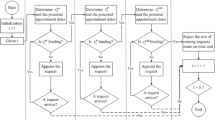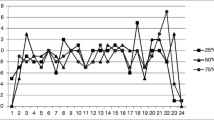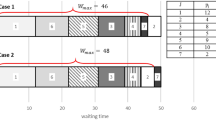Abstract
Even though several clinics serve patients in more than one stage (e.g., visit nurse and then visit doctor) and employ multiple providers in each stage, most of the previous work on appointment system design considers a simplified single-stage single-server clinic. Motivated by a real-life clinic setting, this paper aims to determine the schedule configuration of a hybrid appointment system (i.e., the number of pre-booking and same-day time slots reserved for a physician along with their positions in the schedule) for a two-stage multi-server clinic. A stochastic optimization model is developed to obtain a schedule configuration that minimizes the expected total cost - a weighted sum of excessive patient waiting time, resource idle time, resource overtime, and denied appointment requests. Owing to its computational complexity, we estimate the expected total cost using the sample average approximation method. The proposed model is verified and validated using small test instances and subject matter experts. A case study of a family medicine clinic in Pennsylvania is used to illustrate the proposed approach. The schedule generated by the proposed model results in a significantly lower expected cost compared to the approximated single-stage system’s best schedule configuration and clinic’s existing configuration. Further, sensitivity analysis is conducted to assess the impacts of no-show rate, service time variation, and cost ratios on the schedule configuration. Our findings demonstrate that the schedule configuration is sensitive to changes in the average no-show rate and cost ratios but is not significantly impacted by service time variation. Several managerial insights are also drawn from our analysis. Finally, we provide directions for future research that also highlights the potential to use the revenue management approach to address the problem under study.





Similar content being viewed by others
References
Analysis of American Hospital Association Annual Survey data for community hospitals. (2016) US Census Bureau: National and State Population Estimates, https://www.census.gov/programs-surveys/popest/data/data-sets.2016.html
Collins S, Gunja M, Beutel S (2015) New U.S. Census Data Show the Number of Uninsured Americans Dropped by 8.8 Million. New U.S. Census Data Show the Number of Uninsured Americans Dropped by 8.8 Million, Commonwealth Fund, 16 Sept. 2015, http://www.commonwealthfund.org/blog/2015/new-us-census-data-show-numberuninsured-americans-dropped-88-million
Colwill JM, Cultice JM, Kruse RL (2008) Will generalist physician supply meet demands of an increasing and aging population? Projected shortages could be alleviated if the United States produced four additional generalist graduates in each family and internal medicine residency program each year. Health Aff 27(Suppl1):w232–w241
Hawkins M, et al. (2017) Survey of physician appointment wait times, pp 1-17. Irving, TX [online] https://www.merritthawkins.com/uploadedFiles/MerrittHawkins/Content/Pdf/mha2017waittimesurveyPDF.pdf (accessed 15 May 2018)
Kopach R, DeLaurentis PC, Lawley M, Muthuraman K, Ozsen L, Rardin R, Wan H, Intrevado P, Qu X, Willis D (2007) Effects of clinical characteristics on successful open access scheduling. Health Care Manag Sci 10(2):111–124
Glowacka KJ, Henry RM, May JH (2009) A hybrid data mining/simulation approach for modeling outpatient no-shows in clinic scheduling. J Oper Res Soc 60(8):1056–1068
Lee S, Yih Y (2010) Analysis of an open access scheduling system in outpatient clinics: a simulation study. Simulation 86(8-9):503–518
Erdogan SA, Gose A, Denton B (2015) Online appointment sequencing and scheduling. IIE Trans 47 (11):1267–1286
Singer IA, Regenstein M (2003) Advanced access: ambulatory care redesign and the nation’s safety net. National Association of Public Hospitals and Health Systems
Hoseini B, Cai W, Abdel-Malek L (2018) A carve-out model for primary care appointment scheduling with same-day requests and no-shows. Oper Res Health Care 16:41–58
Srinivas S, Khasawneh MT (2017) Design and analysis of a hybrid appointment system: an optimization approach. Int J Oper Res 29(3):376–399
Kortbeek N, Zonderland ME, Braaksma A, Vliegen IM, Boucherie RJ, Lit- vak N, Hans EW (2014) Designing cyclic appointment schedules for outpatient clinics with scheduled and unscheduled patient arrivals. Perform Eval 80:5–26
Yan C, Tang J, Jiang B, Fung RY (2015) Sequential appointment scheduling considering patient choice and service fairness. Int J Prod Res 53(24):7376–7395
Cayirli T, Veral E (2003) Outpatient scheduling in health care: a review of literature. Prod Oper Manag 12(4):519–549
Srinivas S, Ravindran AR (2017) Systematic review of opportunities to improve outpatient appointment systems. In: IIE annual conference. Proceedings. Institute of Industrial and Systems Engineers (IISE), pp 1697–1702
Gupta D, Denton B (2008) Appointment scheduling in health care: challenges and opportunities. IIE Trans 40(9):800–819
Qu X, Shi J (2011) Modeling the effect of patient choice on the performance of open access scheduling. Int J Prod Econ 129(2):314–327
Peng Y, Qu X, Shi J (2014) A hybrid simulation and genetic algorithm approach to determine the optimal scheduling templates for open access clinics admitting walk-in patients. Comput Indus Eng 72:282–296
Qu X, Rardin RL, Williams JAS, Willis DR (2007) Matching daily healthcare provider capacity to demand in advanced access scheduling systems. Eur J Oper Res 183(2):812–826
Liu N, Ziya S, Kulkarni VG (2010) Dynamic scheduling of outpatient appointments under patient no-shows and cancellations. Manuf Serv Oper Manag 12(2):347–364
Gupta D, Wang L (2008) Revenue management for a primary-care clinic in the presence of patient choice. Oper Res 56(3):576–592
Feldman J, Liu N, Topaloglu H, Ziya S (2014) Appointment scheduling under patient preference and no-show behavior. Oper Res 62(4):794–811
Muthuraman K, Lawley M (2008) A stochastic overbooking model for outpatient clinical scheduling with no-shows. IIE Trans 40(9):820–837
Chen RR, Robinson LW (2014) Sequencing and scheduling appointments with potential call-in patients. Prod Oper Manag 23(9):1522–1538
Ahmadi-Javid A, Jalali Z, Klassen KJ (2017) Outpatient appointment systems in healthcare: a review of optimization studies. Eur J Oper Res 258(1):3–34
Pérez E, Ntaimo L, Malavé CO, Bailey C, McCormack P (2013) Stochastic online appointment scheduling of multi-step sequential procedures in nuclear medicine. Health Care Manag Sci 16(4):281–299
Troy P, Lahrichi N, Porubska D, Rosenberg L (2019) Fine-grained simulation optimization for the design and operations of a multi-activity clinic. Flex Serv Manuf J, 1–30
Klassen KJ, Yoogalingam R (2018) Appointment scheduling in multi-stage outpatient clinics. Health Care Manag Sci, 1–16
Srinivas S, Ravindran AR (2018) Optimizing outpatient appointment system using machine learning algorithms and scheduling rules: a prescriptive analytics framework. Expert Syst Appl 102:245–261
Srinivas S (2016) Evaluating the impact of nature of patient flow and patient availability on the performance of appointment scheduling rules in outpatient clinics. Int J Oper Quant Manag 22(2):93–118
Shapiro A, Philpott A (2007) A tutorial on stochastic programming. Manuscript
Higle JL (2005) Stochastic programming: optimization when uncertainty matters. In: Emerging theory, methods, and applications, pp 30–53. INFORMS
Teter MD, Newman AM, Weiss M (2016) Consistent notation for presenting complex optimization models in technical writing. Surveys Oper Res Manag Sci 21(1):1–17
Kleywegt AJ, Shapiro A, Homem-de-Mello T (2002) The sample average approximation method for stochastic discrete optimization. SIAM J Optim 12(2):479–502
Schütz P, Tomasgard A, Ahmed S (2009) Supply chain design under uncertainty using sample average approximation and dual decomposition. Eur J Oper Res 199(2):409–419
Pagnoncelli BK, Ahmed S, Shapiro A (2009) Sample average approximation method for chance constrained programming: theory and applications. J Optim Theory Appl 142(2):399–416
Robinson S (1997) Simulation model verification and validation: increasing the users’ confidence. In: Andradóttir S, Healey KJ, Withers DH, Nelson BL (eds) Proceedings of the 1997 winter simulation conference
Darivemula S, Huppertz J, Rosenbaum E (2016) Decreasing wait times in a family medicine clinic – a creative approach. J New York State Acad Family Physicians 5(1):35–38
US Department of Commerce (2018) U.S. Census Bureau. Retrieved from www.census.gov/quickfacts/fact/table/elizabethtownboroughpennsylvania/INC110217
Office of the Federal Register (2019) Code of federal regulations. Retrieved from https://www.ecfr.gov/
Olds DM, Clarke SP (2010) The effect of work hours on adverse events and errors in health care. J Safety Res 41(2):153–162
Stimpfel AW, Sloane DM, Aiken LH (2012) The longer the shifts for hospital nurses, the higher the levels of burnout and patient dissatisfaction. Health Aff 31(11):2501–2509
Bradley S, Hax A, Magnanti T (1977) Applied mathematical programming. Addison-Wesley, Reading, pp 278–279
Acknowledgements
The authors would like to thank the management, physicians, and staff at the family medicine clinic in central Pennsylvania, USA, for sharing the data required to test the proposed models, and for providing valuable comments and inputs during model development. The authors are grateful to the entire review team for their valuable feedback that helped us improve our work.
Author information
Authors and Affiliations
Corresponding author
Additional information
Publisher’s note
Springer Nature remains neutral with regard to jurisdictional claims in published maps and institutional affiliations.
Appendices
Appendix A: linearization techniques
In this section, three different linearization techniques are proposed to transform the non-linear constraints to equivalent linear constraints. These linearization techniques are used to avoid non-linearity and formulate stochastic MILP model for designing the hybrid appointment system.
1.1 A.1 Linearization technique - 1
To illustrate Linearization Technique - 1, let us consider the non-negative continuous decision variables, y and xj, where j = 1, 2..., n. In addition, let us consider the following binary decision variables, \({{\Delta }_{i}^{j}}\) where j = 1, 2,..., n and i = 1, 2,..., Ij. If the optimization model seeks to minimizey and if y is equal to the maximum of n non-linear terms, where each non-linear term is the product of one continuous variable and one or more binary decision variables as shown in constraint (37), then the non-linear constraint can be linearized by introducing a binary variable 𝜃j for each xj as shown in Eqs. 38–44
Constraints (38)–(40) becomes active if all the binary variable associated with that constraint is 1 and becomes inactive even if one of the binary variable is 0. For example, if all the \({{\Delta }_{i}^{1}}\)’s are 1, then Constraint (38) becomes y ≥ x1. Even if one of the \({{\Delta }_{i}^{1}}\)’s is equal to 0 then Constraint (38) becomes y ≥ x1 − M. Since M is a large positive number, the constraint is equivalent to y ≥−M and hence inactive. Constraint (44), forces exactly one of the 𝜃j, j = 1, 2,..., n to be active, which in turn forces one of the Constraints (41)–(43) to be active. To ensure feasibility, the 𝜃j, j = 1, 2,..., n corresponding to the maximum value of xjj = 1, 2..., n becomes 1, and ensures that y takes the maximum value of xj. This technique is used to linearize Eqs. (8), (11), (14), and (15).
1.2 A.2 Linearization technique - 2
To illustrate Linearization Technique - 2, let us consider two non-negative continuous decision variables, x and y and I binary decision variables, Δi, where i = 1, 2,..., I. If y is exactly equal to a non-linear term that is characterized by the product of x and Δi, where i = 1, 2,..., I as shown in Eq. 45, then it can be linearized using Eqs. 46–48. The condition represented by this constraint is that the variable y = x, if all the Δi’s are equal to one and y = 0 even if one of the Δi is zero.
If all the Δi’s are equal to one, then Constraints (46) and (47) will force y to be exactly equal to x and Constraint (48) becomes inactive. However, even if one of the Δi’s is equal to 1, then Constraints (46) and (47) will become inactive and Constraint (48) will force y to be equal to 0. This technique is used to linearize Constraints (10), (72)–(74).
In Eq. 45, if we have greater than or equal to (i.e., i.e., \(y \geq x \times \prod \limits _{i=1}^{I} {\Delta }_{i}\)) instead of strict equality, then the non-linear constraint can be linearized just by using Constraint (46).
1.3 A.3 Linearization technique - 3
To illustrate Linearization Technique - 3, let us consider non-negative continuous decision variables, y and xi, where i = 1, 2..., I. If the objective function seeks to maximizey and if y is the maximum of xi, as shown in Eq. 49, then it can be linearized using Eqs. 49–52. To linearize, we introduce a binary variable, δi, where i = 1, 2,..., I.
Constraint (50) ensures that y is greater than or equal to the all the xi’s. In other words, y must be greater than or equal to maximum of xi, where i = 1, 2,..., I. Further, Constraint (51) is active (i.e., y ≤ xi) only when the binary variable, δi, is 1 and Constraint (52) forces exactly one of the binary variables (δi’s) to take a value 1. Therefore, to ensure feasibility of Constraints (50) and (52), Constraint (51) will be active only for the maximum of xi. Thus, Constraints (50) and (51) will force y to be exactly equal to the maximum of xi’s. In this research, we use this procedure to linearize Constraints (18) and (19)
Appendix B: Linearization of the stochastic model
In this section, we present the equivalent linear equations for the non-linear constraints in the stochastic MILP model discussed in Section 5. To linearize Constraints (18) and (19), we introduce two binary variables, namely, δsn and Δsd. The variable δsn takes the value 1 if \(L_{s-1,n}^{N}(\omega ) > b_{sn}^{N} \) and is 0 otherwise. Similarly, Δsd is 1 if \(L_{s-1,d}^{D}(\omega ) > b_{sd}^{D}\) and 0 otherwise. In addition, we also introduce the binary variables \(\theta ^{1}_{ptsn}(\omega )\), \(\theta ^{2}_{ptsn}(\omega )\), \(\theta ^{3}_{ptsn}(\omega )\), \(\theta ^{4}_{ptsn}(\omega )\), \({\Theta }^{1}_{ptsd}(\omega )\), \({\Theta }^{2}_{ptsd}(\omega )\), \({\Theta }^{3}_{ptsd}(\omega )\), \({\Theta }^{4}_{ptsd}(\omega )\), αptsn(ω), and βptsd(ω) to determine the exact maximum for start time and latest completion times of the resources.
Appendix C: Stochastic programming model for a single stage system
In this section, we present the stochastic program model to determine the best schedule configuration of an outpatient clinic with only one stage (doctor). The mathematical model presented in Section 5 can be easily adapted for a single-stage system by eliminating the variables and constraints involving the nurse stage. Therefore, to ensure consistency, we will use the notations presented in Section 5 but without the indices and sets representing the nurse stage. Thus, for the single stage system, the key decision variable is Xptsd(ω) instead of Xptsnd(ω). The objective function (89) is subject to Constraints (90)–(107).
Rights and permissions
About this article
Cite this article
Srinivas, S., Ravindran, A.R. Designing schedule configuration of a hybrid appointment system for a two-stage outpatient clinic with multiple servers. Health Care Manag Sci 23, 360–386 (2020). https://doi.org/10.1007/s10729-019-09501-4
Received:
Accepted:
Published:
Issue Date:
DOI: https://doi.org/10.1007/s10729-019-09501-4




